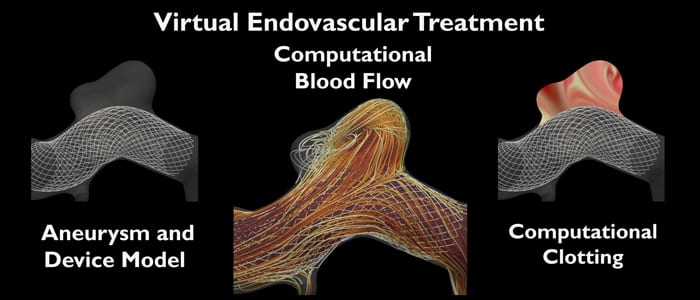Endovascular treatment of brain aneurysms (catheter insertion of a flow diverter or a coil within the aneurysm region) is aimed at reducing blood flow inside the aneurysm leading to generation of a stable clot in the aneurysm sac.
Whether every unruptured aneurysm must be treated immediately upon discovery, and if so, which treatment option represents the least risk to the patient are the questions currently being tackled at the Centre for Computational Imaging & Simulation Technologies in Biomedicine (CISTIB) in the University of Sheffield, UK. The challenge is to evaluate the safety and efficacy of different endovascular treatments in a patient-specific context. Post-treatment ruptures, aneurysm recurrence or incomplete occlusion, and other complications after endovascular treatment further magnify the importance of choosing an appropriate endovascular treatment option.
Virtual endovascular treatment models (VETMs) have been developed to create image-based patient specific models of aneurysm geometries, to virtually deploy endovascular devices, and to simulate intra aneurysmal blood flow. Such endovascular treatment models help clinicians to pre-operatively assess the candidate treatment options and deployment strategies. In a recent review article published in WIREs Systems Biology and Medicine, Sarrami-Foroushani and co-workers reviewed the ingredient models required to build a system for virtual endovascular treatment of aneurysms.
Identification of an appropriate metric to assess post-operative performance of the endovascular treatment is still an active area of research. The authors of this work argued that VETMs should incorporate information about device-induced biochemistry and biology for assessing the device performance and making predictions about aneurysm occlusion and treatment outcomes.
Recently, concerns have been raised about the clinical relevance of computational models by arguing that they are prone to several sources of uncertainty and error that influence the model predictions. Random-effects meta-analysis of the effect of such uncertainties are presented in this work. The authors argued that current deterministic computational simulations need to be extended with strategies for uncertainty mitigation, uncertainty exploration, and sensitivity reduction techniques.
Contributed by the Authors.

















